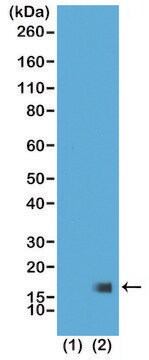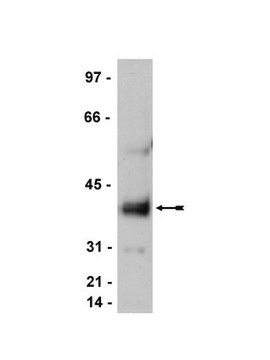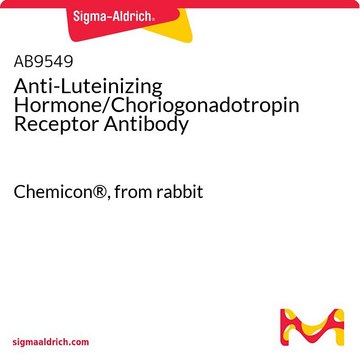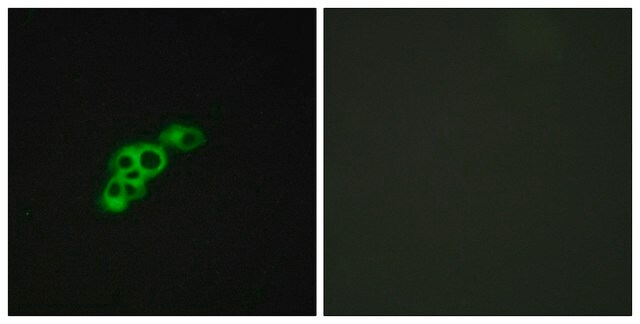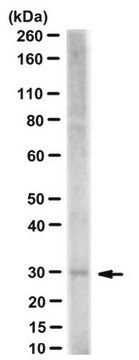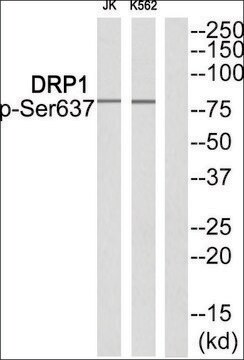MABE1079
Anti-TAF10/TAFII30 Antibody, clone 6TA-2B11
ascites fluid, clone 6TA-2B11, from mouse
Synonyme(s) :
Transcription initiation factor TFIID subunit 10, STAF28, TAF(II)30, TAFII-30, TAFII30, Transcription initiation factor TFIID 30 kDa subunit
About This Item
IP
WB
immunoprecipitation (IP): suitable
western blot: suitable
Produits recommandés
Source biologique
mouse
Niveau de qualité
Forme d'anticorps
ascites fluid
Type de produit anticorps
primary antibodies
Clone
6TA-2B11, monoclonal
Espèces réactives
mouse, human
Technique(s)
immunocytochemistry: suitable
immunoprecipitation (IP): suitable
western blot: suitable
Isotype
IgG1κ
Numéro d'accès NCBI
Numéro d'accès UniProt
Conditions d'expédition
dry ice
Modification post-traductionnelle de la cible
unmodified
Informations sur le gène
human ... TAF10(6881)
Description générale
Spécificité
Immunogène
Application
Western Blotting Analysis: A 1:1,000 dilution of this antibody detected TAF10/TAFII30 in TAFIID complex isolated from HeLa nuclear extract (Courtesy of Dr. Mustapha OULAD-ABDELGHANI, IGBMC, France).
Immunoprecipitation Analysis: A representative lot immunoprecipitated TAF10 together with associated GATA1 from murine erythroleukemia (MEL) cell nuclear extracts (Papadopoulos, P., et al. (2015). Mol. Cell. Biol. 35(12):2103-2118).
Western Blotting Analysis: A representative lot detected TAF10 in E12.5 mouse fetal liver nuclear extracts and murine erythroleukemia (MEL) cell nuclear extracts, as well as in GATA1 immunoprecipitate from MEL cell and fetal liver nuclear extracts (Papadopoulos, P., et al. (2015). Mol. Cell. Biol. 35(12):2103-2118).
Immunocytochemistry Analysis: A representative lot detected TAF10 immunoreactivity in trophoblasts from 3-day cultured wild-type, but not Taf10-/-mouse embryonic blastocysts isolated at 3.5 dpc (days post-coitum) by immunofluorescent staining of 1% paraformaldehyde-fixed, 0.1% Tween 20-permeabilized blastocysts (Mohan, W.S. Jr, et al. (2003). Mol .Cell. Biol. 23(12):4307-4318).
Epigenetics & Nuclear Function
Transcription Factors
Qualité
Western Blotting Analysis: A 1:2,000 dilution of this antibody detected TAF10/TAFII30 in 10 µg of A431 cell lysate.
Description de la cible
Forme physique
Stockage et stabilité
Handling Recommendations: Upon receipt and prior to removing the cap, centrifuge the vial and gently mix the solution. Aliquot into microcentrifuge tubes and store at -20°C. Avoid repeated freeze/thaw cycles, which may damage IgG and affect product performance.
Autres remarques
Clause de non-responsabilité
Vous ne trouvez pas le bon produit ?
Essayez notre Outil de sélection de produits.
Code de la classe de stockage
12 - Non Combustible Liquids
Classe de danger pour l'eau (WGK)
WGK 1
Point d'éclair (°F)
Not applicable
Point d'éclair (°C)
Not applicable
Certificats d'analyse (COA)
Recherchez un Certificats d'analyse (COA) en saisissant le numéro de lot du produit. Les numéros de lot figurent sur l'étiquette du produit après les mots "Lot" ou "Batch".
Déjà en possession de ce produit ?
Retrouvez la documentation relative aux produits que vous avez récemment achetés dans la Bibliothèque de documents.
Notre équipe de scientifiques dispose d'une expérience dans tous les secteurs de la recherche, notamment en sciences de la vie, science des matériaux, synthèse chimique, chromatographie, analyse et dans de nombreux autres domaines..
Contacter notre Service technique

